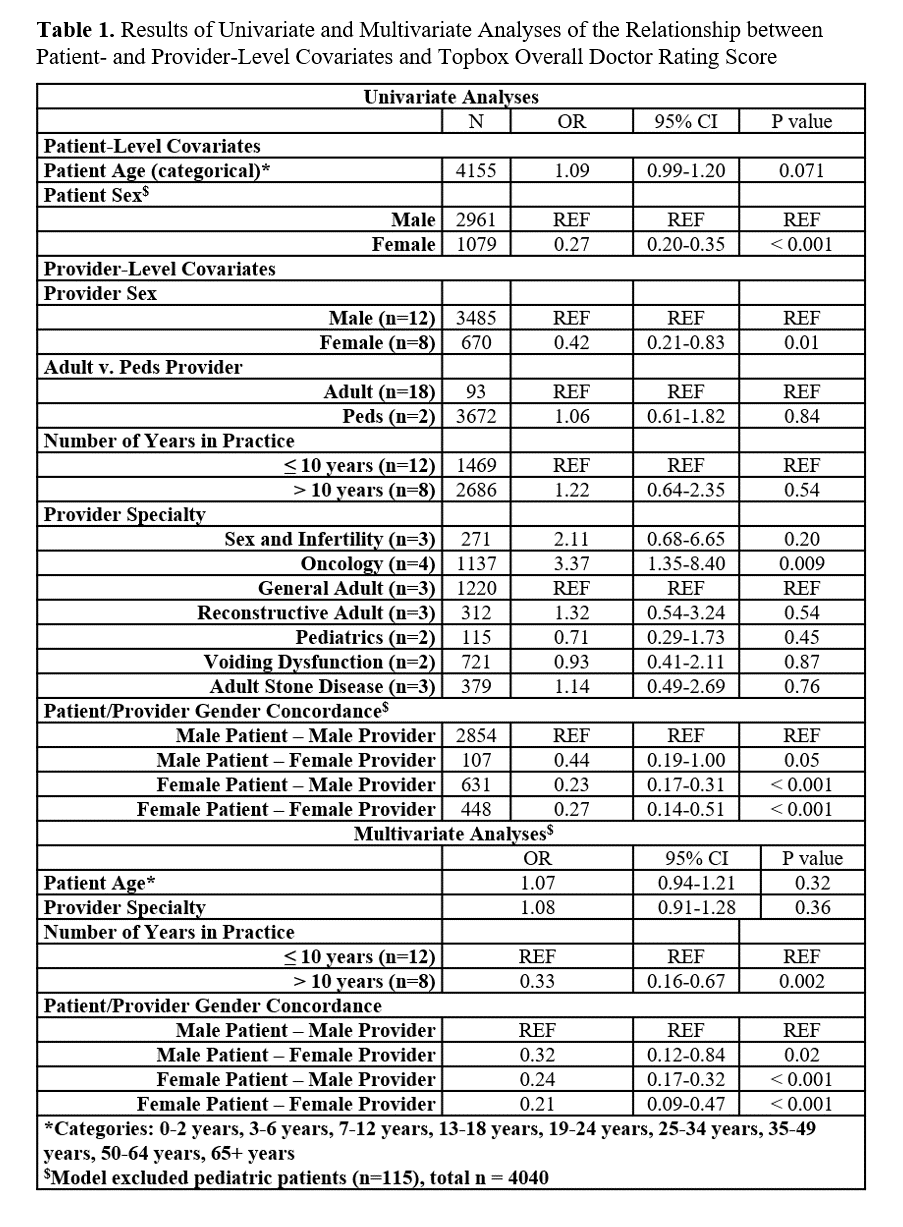Back
Poster, Podium & Video Sessions
Best Poster Award
MP39: Health Services Research: Value of Care: Cost and Outcomes Measures
MP39-07: The Impact of Patient and Provider Demographics on Press Ganey&[reg] Ratings in Urology: Who is at Risk of Bias?
Sunday, May 15, 2022
8:45 AM – 10:00 AM
Location: Room 228
Jane Kurtzman, Connie Wang*, Edwin Melendez, Julia Finkelstein, Christina Carpenter, New York, NY

Connie Wang, MD
Columbia University Irving Medical Center
Poster Presenter(s)
Introduction: Patient satisfaction scores are considered a quality measure in healthcare delivery and are increasingly incorporated into physician evaluations – impacting compensation and promotions. The Press Ganey® (PG) survey is the largest patient satisfaction measurement tool. Recent literature has suggested a bias against female (F) providers in PG physician ratings across many subspecialties. We aimed to examine the effect of patients’ age and sex and providers’ sex and subspecialty on PG ratings for urologists.
Methods: We analyzed all patient-completed PG surveys from February 2020 – August 2021. The primary outcome was a “topbox” Overall Doctor Rating (topbox-ODR) score of a 9 or 10 (out of 10). Univariate and multivariate logistic regression models using generalized estimating equations to account for correlated outcomes among providers were used to assess the relationship between patient- and provider-level covariates and the primary outcome.
Results: 4,155 surveys, completed for 20 attending urologists (8 F) across 7 subspecialities, were assessed. Mean ODR score for F providers was 9.2 (SD 1.7) compared to 9.5 (SD 1.3) for males (M), p < 0.001. Table 1 displays the results of all analyses. Univariate regression demonstrated that F patients are less likely (OR 0.27, p < 0.001) to give topbox-ODRs than M patients, and F providers are 58% less likely (OR 0.42, p = 0.01) to receive topbox-ODRs than M providers. Oncologists are more likely to receive topbox-ODRs (OR 3.3, p = 0.009) than all other subspecialties. Multivariate regression demonstrated that M patients are more likely to give top-box-ODRs to M providers than they are to F providers (OR 0.32, p = 0.02), while F patients are less likely to give topbox-ODRs to both M and F providers (M: OR 0.24, p < 0.001; F: 0.21, p < 0.001). Providers in practice for = 10 years are 66% less likely to receive top-box-ODRs (OR 0.33, p = 0.002).
Conclusions: Urologists who care for F patients are at-risk of being affected by bias in PG physician ratings. M providers who care for M patients appear to be at least risk. Our results are the first of their kind in urology, and we recommend deemphasizing the role of PG scores in physician compensation and promotion decisions until further inquiries are pursued.
Source of Funding: None

Methods: We analyzed all patient-completed PG surveys from February 2020 – August 2021. The primary outcome was a “topbox” Overall Doctor Rating (topbox-ODR) score of a 9 or 10 (out of 10). Univariate and multivariate logistic regression models using generalized estimating equations to account for correlated outcomes among providers were used to assess the relationship between patient- and provider-level covariates and the primary outcome.
Results: 4,155 surveys, completed for 20 attending urologists (8 F) across 7 subspecialities, were assessed. Mean ODR score for F providers was 9.2 (SD 1.7) compared to 9.5 (SD 1.3) for males (M), p < 0.001. Table 1 displays the results of all analyses. Univariate regression demonstrated that F patients are less likely (OR 0.27, p < 0.001) to give topbox-ODRs than M patients, and F providers are 58% less likely (OR 0.42, p = 0.01) to receive topbox-ODRs than M providers. Oncologists are more likely to receive topbox-ODRs (OR 3.3, p = 0.009) than all other subspecialties. Multivariate regression demonstrated that M patients are more likely to give top-box-ODRs to M providers than they are to F providers (OR 0.32, p = 0.02), while F patients are less likely to give topbox-ODRs to both M and F providers (M: OR 0.24, p < 0.001; F: 0.21, p < 0.001). Providers in practice for = 10 years are 66% less likely to receive top-box-ODRs (OR 0.33, p = 0.002).
Conclusions: Urologists who care for F patients are at-risk of being affected by bias in PG physician ratings. M providers who care for M patients appear to be at least risk. Our results are the first of their kind in urology, and we recommend deemphasizing the role of PG scores in physician compensation and promotion decisions until further inquiries are pursued.
Source of Funding: None


.jpg)
.jpg)